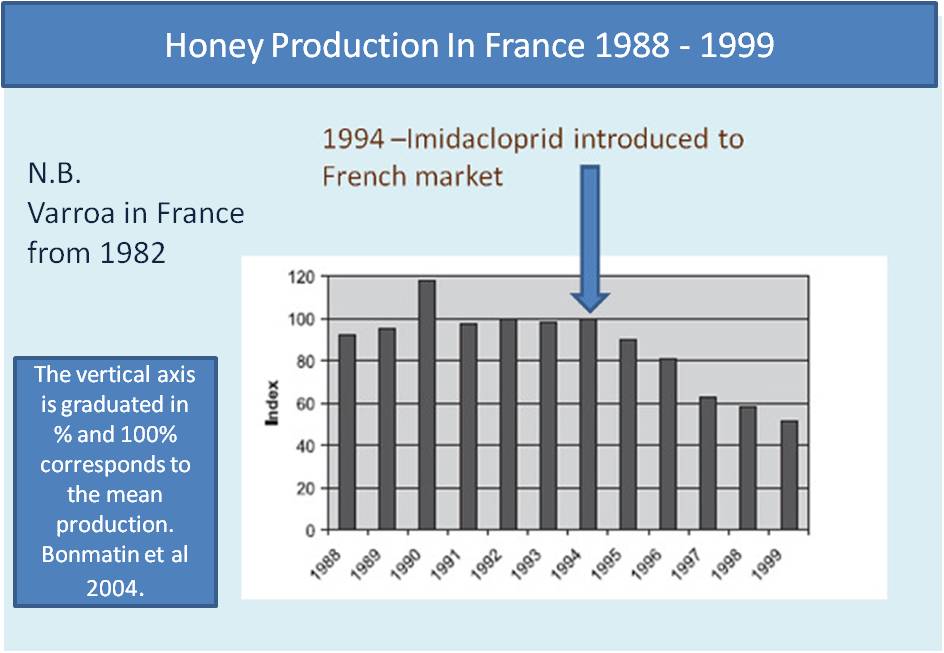Bee Hive Losses In California
Earlier last month (February 2019) National Public Radio Inc reported on thousands of hives in California (1).
The story told the reader that Bret Adee, owner of one of the largest commercial beekeeping companies in the US, lost around half of his hives over winter. The loss totaled about 50,000 hives.
Adee takes his hives to the almond groves of Central Valley, California, where honey bees are vital for the pollination of this important commercial crop.
However, the article tells us that some beekeepers reported even higher losses than Bret Adee, with losses up to 80%, and that 40% is not unusual these days.
What is the cause of these extremely high colony losses?
The article refers to comment by 'bee expert' Ramesh Sagili, of Oregon State University, who says it's Varroa mite:
"It's a very lethal parasite on honey bees," Sagili says. "It
causes significant damage not only to the bee, but to the entire colony. A
colony might be decimated in months if this varroa mite isn't taken care
of."
Is this a valid argument?
I'm not so sure, and other campaigners and beekeepers agree.
“There
is a big flaw in that theory..” says beekeeper and campaigner, Graham White.
“Every single bee colony in France and Germany was infested with varroa mites from around 1980 - they were universal.
But
you can search the academic and beekeeping archives for the period 1980 to 1998
- and there is not ONE article about mass bee deaths from varroa infestation in
Europe.
But
in 1998, Bayer introduced Imidacloprid on the sunflower crop in France -
and BANG - they lost ONE MILLION BEE COLONIES IN ONE SEASON.
Varroa
mites do not wipe out healthy colonies. But any colony which has been
weakened by neonicotinoids, which ALSO has varroa mites, is doomed.
Varroa
is being used as ‘the fall guy’ in America to take the blame for the death of
20,000,000 bee colonies since 2003.”..........
Certainly we are not given any further analysis about the hives: the presence of toxins or other diseases, for example.
Neonicotinoids weaken honey bees and make them more susceptible to diseases and viruses, including Varroa
Graham White has a point. Varroa has been present in France since 1982, but it is only since the introduction of neonicotinoids that effects became noticeable.

Anyway, potentially, neonicotinoids could hamper the ability of bees to deal with Varroa mite, by for example, hampering the honey bee's natural defenses.
That neonicotinoids may are implicated in higher vulnerability to disease and viruses has already been indicated in other reports.
For example, neonicotinoids are implicated in the proliferation of nosema in bees.....
.....as well as deformed wing virus.
Secondly, we are seeing declines of other bee and insect species where Varroa is not a factor, especially on farmland, in tandem with farmland birds.
Agricultural practices and using insecticides in particular, is a key contributory cause.
After decades of evidence, the problems need to be acknowledged honestly
I recall in 2014, the Pollinator Stewardship Council reported 80,000 had been poisoned in the California almond groves, whilst a further 400,000 colonies were affected.
And then I am reminded of a comment in June 2007 in a very revealing document by Mr Warren Jones, President of the Australian Crop Pollinators, “Future Development of the Australian Honey Bee Industry”.
On page 4 he writes:
“There has been a wide use of neonicotinoids to treat a large range of pasture seed and other seed prior to planting which includes most of our horticulture and vegetable production.
Consequently our bees are continually in contact with neonicotinoids from the agricultural environment.
We are finding it very
difficult to maintain our hives at pollination strength, requiring an increase
in use of young queens and replacement nucleus hives to maintain our hives”
By Autumn 2009, Warren
Jones commented to The Australian Organic Producer in “Where Have All The Bees
Gone?”:
“Currently
in Australia the demand has never been higher for bee pollination but until
more control on the use of neonicotinoids is
established available bee numbers are unlikely to improve."
Once all have acknowledged the source of the problems, only then can they be dealt with. In the meantime, neonicotinoids continue to poison the landscape.
References
(1) Massive Loss Of Thousands Of Hives Afflicts Orchard Growers And Beekeepers, February 18, 20194:28 PM; NWPR.org: https://www.npr.org/sections/thesalt/2019/02/18/
694301239/massive-loss-of-thousands-of-hives-afflicts-orchard-growers-and-beekeepers?t=1551882255156
If you found this page helpful or interesting, I'd really be grateful if you would share it with others - if not this page, perhaps another, such as Gardening For Bees.
Thank you so much :) .